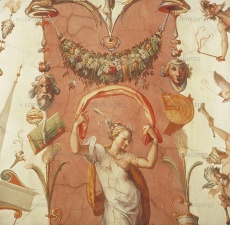"Bussola Morta" (Dead Compass)
From Inventions
m (1 revision) |
|||
| (8 intermediate revisions not shown) | |||
| Line 1: | Line 1: | ||
{{Template invention | {{Template invention | ||
| - | |nome= | + | |nome= |
| + | Name used in Renaissance times, especially in the Veneto region. | ||
| - | |descrizione= | + | |descrizione= |
| - | + | Instrument for transferring the data acquired in a survey to a drawing. This name is found only in the treatise by Vincenzo Scamozzi (''L’idea della architettura universale'', Venice 1615, Part I, Book I, Chap. XV, p. 51: "The letter H represents the ''Bossola morta'', to put the Sites on a drawing") and from the indications it would seem to be a goniometric circle, carrying the same divisions as those of the [[Surveying Compass | surveying compass]], and equipped with a ruler and an altazimuth square. It was used to transfer surveying data, i.e., position angles and distances from the surveying station, onto a sheet of drawing paper. The instrument was called "morta" (dead) because it had no magnetized needle. The compass with magnetized needle, or [[Surveying Compass | surveying compass]], was thus called [["Bussola viva" (Alive Compass) |"bussola viva" (alive compass)]]. | |
| - | + | ||
| - | + | ||
| - | + | ||
| + | |inventore= | ||
| + | |data= | ||
|componenti= | |componenti= | ||
| Line 19: | Line 19: | ||
|immagini= <gallery widths=230 heights=368 perrow=3> | |immagini= <gallery widths=230 heights=368 perrow=3> | ||
| - | Image: 3153_2021_0968-061.jpg | | + | Image: 3153_2021_0968-061.jpg | Florence, Galleria degli Uffizi, East Corridor, ceiling decoration, bay 30. |
| Line 26: | Line 26: | ||
|autore_scheda= Filippo Camerota | |autore_scheda= Filippo Camerota | ||
| - | |categoria_1= | + | |categoria_1= |
|categoria_2= | |categoria_2= | ||
|categoria_3= | |categoria_3= | ||
| Line 40: | Line 40: | ||
}} | }} | ||
| + | |||
| + | [[Category:Measuring instruments|Bussola Morta]] | ||
Current revision as of 10:18, 12 November 2009
Name used in Renaissance times, especially in the Veneto region.
Description
Instrument for transferring the data acquired in a survey to a drawing. This name is found only in the treatise by Vincenzo Scamozzi (L’idea della architettura universale, Venice 1615, Part I, Book I, Chap. XV, p. 51: "The letter H represents the Bossola morta, to put the Sites on a drawing") and from the indications it would seem to be a goniometric circle, carrying the same divisions as those of the surveying compass, and equipped with a ruler and an altazimuth square. It was used to transfer surveying data, i.e., position angles and distances from the surveying station, onto a sheet of drawing paper. The instrument was called "morta" (dead) because it had no magnetized needle. The compass with magnetized needle, or surveying compass, was thus called "bussola viva" (alive compass).
Bibliographical Resources
Scamozzi, Vincenzo. L’idea della architettura universale, Venezia 1615, Parte I, Lib. I, Cap. XV, p. 51.
Images
Author of the entry: Filippo Camerota

